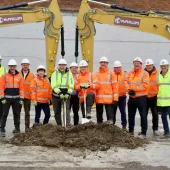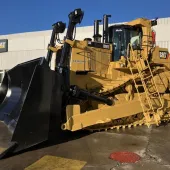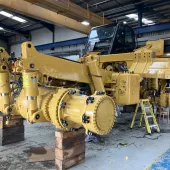The Coldest Journey team safely back in UK

Finning engineers return from freezing Antarctic winter journey having helped to raise $2 million for charity
AFTER 307 days in the Antarctic guiding Rover and Seeker, the two specially designed Antarctic Cat D6Ns, Finning engineers Spencer Smirl and Richmond Dykes have made a safe return to the UK.
As part of ‘The Coldest Journey’ expedition conceived by Sir Ranulph Fiennes, the two men have helped to raise $2 million for the ‘Seeing is Believing’ charity.
Breaking records for the operation of dozers in the world’s harshest conditions, Messrs Smirl and Dykes were faced with winds of up to 125km/h, delivering a wind chill of –88 degrees Celsius.
Throughout the expedition, the two engineers maintained and operated the two Cat D6Ns, manoeuvring across crevasse fields and blue ice, whilst towing science and accommodation cabooses in an ice train.
Commenting on the expedition and its achievements, Sir Ranulph Fiennes said: ‘They are the first team ever to camp throughout the Antarctic winter in the permanent darkness and temperatures as low as –60 degrees Celsius, and they achieved one of the longest Antarctic journeys in winter.
‘In addition, through their association with the international charity ‘Seeing is Believing’, which is committed to eradicating avoidable blindness in the developing world, the expedition has raised funds which are being matched dollar for dollar by Standard Chartered Bank.’
Commenting on his personal experience of the expedition, Spencer Smirl (pictured on left), said: ‘This was an unbelievable journey, pitting man and machine against the most unpredictable and harsh conditions on the planet. When you are relying on a Cat D6N to travel in temperatures as low as –60 degrees Celsius, in the dark, you know your focus has to be on the performance of the machine.
‘But in order to keep it performing well, you have to keep yourself in top condition, alert to every possible issue and ready at any moment to perform maintenance, change plans and support the rest of the team. Both Richmond and myself have had our engineering skills tested to the max and it has been such a rewarding and amazing experience.
‘Even though the main goal of the expedition, to traverse the Antarctic in winter, had to be changed due to weather conditions, we have broken dozer records and been able to achieve our own key goals for the expedition.
‘And by getting the team and equipment back safe and sound, we have proven that the vision of Sir Ranulph Fiennes, to develop Antarctic-ready Cat D6Ns that can operate in the Antarctic winter, has been achieved.
‘Words can’t describe the whole experience, but it has certainly been life changing.’
In total, 2,500 miles were travelled by the two dozers, which carried out various tasks throughout the journey. During this time the Finning engineers performed numerous essential machine maintenance tasks, protected by a specially designed canopy. With daily routines, checks and analysis combined with the removal of snow and ice, hundreds of man-hours were spent looking after the Cat D6Ns.
Commenting on the performance of the Cat D6Ns, Richmond Dykes (pictured on right) said: ‘For the Cat D6Ns, this has been a three-year journey, with 5 months of it operating in the Antarctic. Designed by Finning engineers at the company’s Cannock headquarters, the performance of the Antarctic-ready Cat D6Ns has been fantastic.
‘This was completely new territory for everyone involved and our ultimate goal as engineers was to deliver the whole team and equipment back safe and sound, so it is fantastic to have achieved this. Throughout the journey, I think we have become one with virtually every part of Rover and Seeker and alert to the tiniest of differences in performance.
‘We are both now in a unique position to share our experiences with others and in particular our fellow engineers across the whole Finning and Caterpillar businesses. The knowledge that we have gained will certainly make a difference to the future of plant equipment development and, most importantly, the safety of the engineers that maintain it.
‘We are both quite sad to leave such an amazing place, but are very excited about the future and can’t wait to thank everyone that has helped us make this journey possible. These experiences are once in a lifetime opportunities and we have both felt privileged to take part.’
He added: ‘I know I speak for both of us when I say that being part of something that has raised so much money for a charity like ‘Seeing is Believing’, that gives the gift of sight, is very humbling. We both hope to do more to raise awareness for the charity and hope to push the overall total beyond $2 million.'









